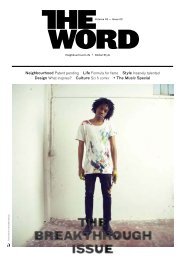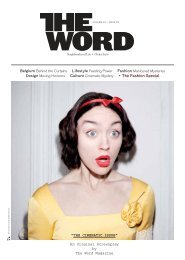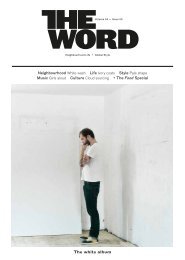download as PDF - The Word Magazine
download as PDF - The Word Magazine
download as PDF - The Word Magazine
You also want an ePaper? Increase the reach of your titles
YUMPU automatically turns print PDFs into web optimized ePapers that Google loves.
the institution<br />
<strong>The</strong> Man<br />
Down Under<br />
— In the preface to<br />
“Brüsel”, the ninth<br />
publication of famed<br />
Belgian comic “Les<br />
Cités Obscures”, writers<br />
Schuiten and Peeters<br />
warn us: by loosing its<br />
very essence, Brussels lost<br />
its soul. <strong>The</strong> “essence”<br />
they refer to is the Senne,<br />
a 103 km long river of<br />
which 45 km used to swirl<br />
across Brussels’ centre<br />
area before being covered<br />
up and buried like a longforgotten<br />
fi lthy old lady in<br />
the 19th and 20th century.<br />
<strong>The</strong> truth is, since the<br />
completion of new sewage<br />
treatment plants in March<br />
2007, the old lady is<br />
today much cleaner,<br />
alive and fl owing. And if<br />
you know where to meet<br />
her, you will fi nd that<br />
Brussels’s soul is hidden<br />
underground.<br />
Writer Jacques Moyersoen<br />
40 — THE THIRD WORD<br />
<strong>The</strong> Covering of the Senne<br />
At the beginning of the 19 th century, Brussels,<br />
and in particular the lower parts of town,<br />
w<strong>as</strong> in many ways still a very medieval city,<br />
characterized not only by the course of the<br />
Senne, but also by an illogical street layout,<br />
hard to access islands, back alleys, narrow<br />
streets, unregulated bridges, and numerous<br />
dead ends. Although this may today sound<br />
charming, it did at the time trigger its own<br />
set of problems, and not only traffi c-wise.<br />
<strong>The</strong> Senne had since long lost its usefulness<br />
<strong>as</strong> a navigable waterway, being replaced by<br />
canals. And no one ever dreamed of catching<br />
a fi sh in the once pure clear river. In fact,<br />
its main purpose w<strong>as</strong> <strong>as</strong> a dump for garbage,<br />
detritus and industrial w<strong>as</strong>te spreading pestilential<br />
odours throughout the city. Early<br />
in the second half of the 19th century, Brussels<br />
saw numerous dry periods, fl oods and<br />
a cholera epidemic, caused <strong>as</strong> much by the<br />
river itself <strong>as</strong> by the poverty and the lack of<br />
hygiene and potable water in the lower city.<br />
This forced the government to act.<br />
In 1867, after much debate, mayor Jules<br />
Anspach decided to cover up the Senne.<br />
Constructed from bricks, the covering w<strong>as</strong><br />
to be 2.2 kilometres long and w<strong>as</strong> to consist<br />
of two parallel 6 m (20 ft) wide tunnels, and<br />
a set of two lateral drainage pipes, each taking<br />
in w<strong>as</strong>tewater from its respective side of<br />
the street. Inspired by Haussmann’s renovation<br />
of Paris, it served the mayor’s ambitious<br />
plan to transform the impoverished lower<br />
city in a more modern, business-friendly<br />
centre. <strong>The</strong> elimination of the numerous<br />
alleys and dead-ends in the lower town in<br />
favour of straight, wide and open-air boulevards<br />
– thus linking the city’s two rapidly<br />
growing train stations - seemed both a necessity<br />
and an opportunity to beautify the<br />
city and improve both traffi c circulation<br />
and hygiene. <strong>The</strong> project, which expropriated<br />
tens of thousands of homes and took<br />
four years to complete, created the series<br />
of boulevards we today know <strong>as</strong> Maurice<br />
Lemonnier Boulevard, Anspach Boulevard,<br />
Adolphe Max Boulevard, and Emile Jacqmain<br />
Boulevard.<br />
<strong>The</strong> covering up w<strong>as</strong> completed in 1930<br />
when the Senne w<strong>as</strong> channelled into subterranean<br />
tunnels for nearly its entire course<br />
through the Brussels metropolitan area.<br />
A Smelly Promenade<br />
Today, Brussels’ network of drains, sewers,<br />
and drainage pipes forms an underground<br />
maze of about 350 kilometres. It is so v<strong>as</strong>t<br />
and complex that an experienced visitor<br />
could walk from the capital’s Central Sta-<br />
tion to Arlon, on the country’s southernwestern<br />
tip, without ever stepping outside.<br />
Complete with its own underground street<br />
sign, explorers travel through tunnels of various<br />
shapes and structures, refl ecting years<br />
of development: stone, brick, and then concrete.<br />
It is a city within a city, a dank, f<strong>as</strong>cinating<br />
demimonde from which one emerges<br />
blinking and mesmerised.<br />
Sewers are a true museum of horrors<br />
too. Home to the most repugnant fauna, the<br />
drains also prove to be the ideal refuge for<br />
rats. It is thought that two million of them<br />
(the equivalent of two rats per habitant)<br />
wander Brussels’ underground, eating one<br />
third of all the fl oating w<strong>as</strong>te. And they can<br />
be big! Up to 50cm long. Small shrimps,<br />
mussels, aquatic snails and tribes of cockroaches<br />
are also to be found in disgusting<br />
quantity. However, unlike in New York and<br />
Paris nobody h<strong>as</strong> yet been senseless enough<br />
to fl ush a baby alligator down the toilet! Until<br />
ten years ago, the sewers were also a theatre<br />
to a strange spectacle. Every Tuesday and<br />
Thursday the w<strong>as</strong>tewater took a bloody-red<br />
taint because it w<strong>as</strong> slaughtering day at the<br />
Anderlecht’s Cureghem abattoirs.<br />
Exploring these mysterious paths of darkness<br />
and insalubrities may bring excitement to<br />
some but it is actually illegal. Thankfully, the<br />
Brussels Sewer Museum, manages to feed our<br />
curiosity for the city’s unknown secrets with<br />
a safe and quite hygienic alternative. Unfairly<br />
overlooked, the freshly revamped museum<br />
offers three levels of historical and technical<br />
explanations. And if you can stand the smell,<br />
there’s even an access to an illuminated and<br />
cleaned section of Brussels’ underground<br />
world of drains and sewers. It is also the only<br />
place in Brussels where you can offi cially lay<br />
your eyes on the covered Senne. What makes<br />
the experience even more fun is that the<br />
guides you can book to walk you through are<br />
all authentically jolly sewer workers.<br />
A Dangerous Job<br />
Guy Delvallée, the man now responsible for<br />
the Brussels Sewer Museum, worked during<br />
ten years maintaining the sewers, drains<br />
and the Senne clean. <strong>The</strong>re are no studies<br />
to become égoutiers, so he learned everything<br />
on the job. He recalls: “It is tough<br />
physically and mentally working 8-hours a<br />
day down there. <strong>The</strong>re’s 98 to 100% humidity<br />
so you’re quickly prone to rheumatism.<br />
Also, during winter you spend entire days<br />
without ever seeing the daylight. Eventually,<br />
like a vampire, you end up avoiding all<br />
contact with daylight because it is too bright<br />
for your non-accommodated eyes to stand!
















